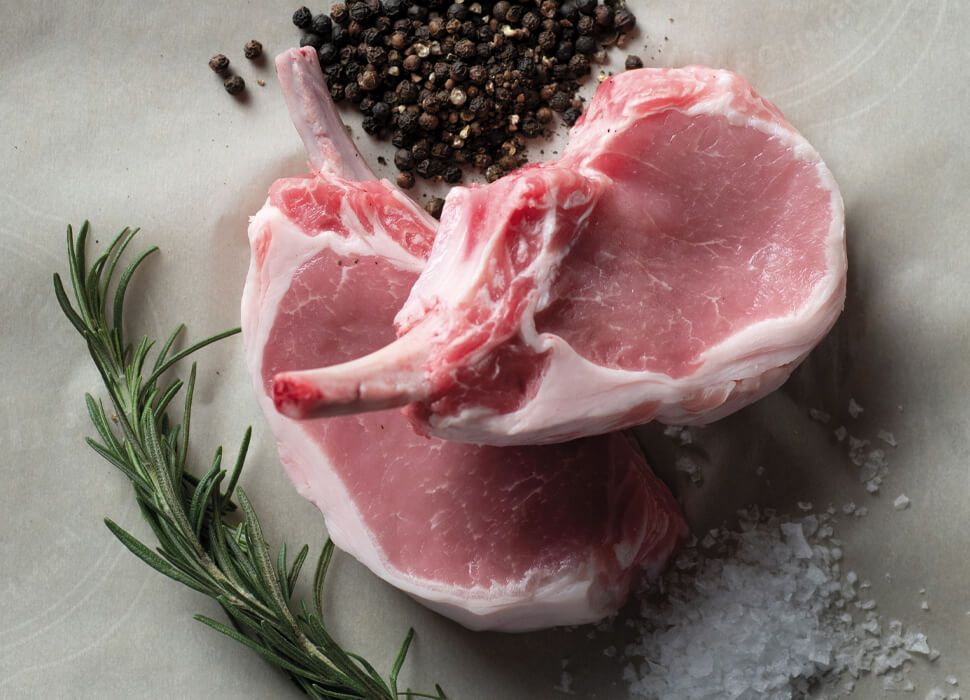Serving ham as the centerpiece of a holiday entree has been around for ages — from ancient Germanic practices to 19th-century Britain. And families today are still choosing this popular main feature to feed their holiday crowds. In fact, according to a survey on the most popular Christmas dishes, 62% of Americans choose ham, ranking it #11 on the list of most popular holiday dishes.
Ham is an incredibly flavorful meat on its own, and it complements a wide variety of side dishes quite well. It’s versatile, allowing home cooks to use glazes, spices, and rubs of all kinds. Many families use ham as the second protein even if it is not the main course. Best of all, ham can yield a lot of meat for a large crowd — not to mention store well and be enjoyed as leftovers.
Convinced that serving ham this holiday season is the right route for you? This guide will talk you through how to choose a ham, based on your needs and tastes and size of your gathering.
Bone-In vs. Boneless vs. Spiral Holiday Hams
There are three primary types of cuts when it comes to ham: bone-in, boneless, and spiral which can be bone-in or boneless. Each of these cuts offers benefits, so it really comes down to personal preference.
Boneless Ham
Of course, a boneless ham will be easiest to slice. If this is your first time serving ham for a crowd, or you need the convenience of a quick cutting job, you might opt for boneless. Boneless hams sometimes come pre-sliced to make your job even easier. Cooking times for boneless ham tend to be slightly shorter than those of the bone-in variety.
Bone-In Ham
But if it’s the ultimate flavor you’re after, consider choosing a bone-in ham. The bone actually helps carry flavor and disperse it throughout the meat. A traditional bone-in ham also makes a nice centerpiece for your holiday table. Naturally, slicing a bone-in ham takes a bit more finesse, so you may want to do a trial run before your big holiday event.
A semi-boneless ham offers the best of both worlds. It maintains the flavor by keeping portions of bone, but has the hip and shank bones removed for easier slicing and serving.
When you’re looking for a whole ham you may consider a skinless shank-less ham. As the name states the ham has been skinned and the shank has been removed leaving just the small leg bone. This makes the ham much easier to carve than a traditional whole bone in ham.
Spiral Ham
Finally, a spiral ham is an especially popular cut for holidays and large crowds. This is the cut most people probably think of in the classic image of a table set for the holidays. Most often the bone has been preserved within the ham, and the butcher has pre-cut a spiral shape, making at-home slicing easier. Boneless options are available, but less common. Be careful not to overheat a spiral ham. Because it is pre-sliced, it has a tendency to dry out when overheated.
Cured vs. Uncured Holiday Hams
Since ham provides so much versatility, butchers have found myriad ways to prepare it prior to your purchase. Curing and aging are two processes that can significantly change the flavor of ham.
Curing is a process in which the meat is coated in a solution that might include acid, salt, sugar, or other food preservatives, which also help remove excess moisture. These cured meats are then hung to dry in temperature- and humidity-controlled environments for days, months, or even years. The aging process allows for extra flavor concentration.
Many meat products — including bacon and sausage — are cured, whether with artificial curing agents or natural ingredients. Uncured hams, for instance, are still cured prior to packaging, but with natural curing agents like cultured celery powder and sea salt. Coleman Natural has a variety of uncured hams to choose from. We always use natural curing ingredients and never added artificial preservatives like nitrates and nitrites.
City Hams
City hams are the most commonly found hams at the grocery store. They come pre-cooked so all you have to do is heat them through to the proper internal temperature (140-150 degrees Fahrenheit) when ready to eat. City hams typically come wet-cured, which involves the same types of spices and preservatives used during the traditional curing process, only they’re formulated into a brine and then injected into the meat. Some are placed in a saltwater solution for an extended period instead. A city ham can be pressed and formed using different ham muscles and fillers – be sure to read the ingredients closely.
Fresh Hams
Fresh hams are specialty cut and must be bought from a butcher. Typically they are only available around the holidays at your local grocer unless they are special ordered. They’re neither cooked nor cured, so you must really know what you’re doing to properly handle, prepare, and cook this raw meat to the correct internal temperature. Be sure to purchase fresh hams from a reputable source.
Country Hams
Country hams are another option, but very different from city hams or fresh hams. Country hams are salt cured for several months and are a staple in certain southeastern states. They tend to be a very salty ham because of the curing process. This gives country ham a reputation for a stronger salty flavor profile, which may work wonderfully for cooks who are looking for that umami flavor. Country hams are aged anywhere from several months to a few years. Because of the curing process they are shelf stable and will be displayed out of refrigeration at your grocer.
Shank vs. Butt
When you’re looking for the perfect ham for your event, consider the cut. Whole hams include both the shank, which is the lower leg, and the portion known as butt, which is the top part of the leg and shoulder. But a whole ham is quite large, and if you’re feeding a smaller crowd, you might be looking at a half ham instead.
Half hams include one or the other — the shank or butt. This is why you’ll see half hams of differing sizes and shapes when scanning the grocery aisle. A shank is considered more aesthetically pleasing, giving your ham that classic “holiday centerpiece” look. It has a little more fat, but is easy for carving. A butt tends to be leaner, so it’s not quite as plump. Half hams that include the butt are smaller than those from the shank. They can be slightly more difficult to carve, but can ultimately yield more servings. The butt will be a little more expensive in some grocers but may be worth it because of the additional meat yield.
Determining Quality
So now that you’ve got the cuts and the curing down, it’s time to focus on quality. Two primary indicators when shopping for high-quality ham are freshness and color. The very first thing to look for is the “Sell by” date. When it comes to selecting a ham, the rule of thumb is “the later the date, the fresher the ham.”
Color will vary depending on how the ham is prepared prior to packaging. Cured ham is almost always a dark rose or pinkish hue, while uncured ham is a paler pink or beige color. Country hams might range anywhere from dark red to mahogany.
There’s one more indicator to be aware of when you’re shopping for the perfect ham: its water content. Remember that brine is often injected into hams during the wet-curing process. But excess water might also be added in order to lower cost and increase the product’s shipping weight, so you’re actually getting less meat. This can be disconcerting for consumers, but looking at the label can help you spot any issues, since manufacturers are required to label hams differently according to their water content.
Quality and Water Content
- “Ham” is your best bet as it has no added water.
- “Ham with natural juices” could have up to 7-8% water. Also, check what the “juices” are that are added.
- “Ham, water added” can contain up to 10% water.
- “Ham and water product” has no limit on the amount of water added and best avoided if you want higher quality and more bang for your buck.
And if you’re health-conscious, you’ll probably want to avoid canned hams, since they almost always contain excess water, a variety of preservatives, and other unnecessary ingredients.
How Much Ham Will Feed Your Group?
As far as the size of ham you’ll need, that will depend on the number of people in your group (and their appetites!) You can plan for roughly ½ pound of boneless ham per person, or ¾ pound of bone-in ham per person, with some caveats.
If some of the mouths you’ll be feeding are children, cut your per-person estimations down by ¼ pound for those smaller appetites. On the flip side, if you’re feeding mostly adults or hungry teens, increase your estimations by ¼ pound per person. Additionally, if you’re serving other types of meats, factor this into your per-person calculation. You can find a handy calculator here to help you plan.
Example calculation for boneless ham
- 10 adults x ½ lb. of ham each = 5 pounds of ham
- 8 small kids x ¼ lb. of ham each = 2 pounds of ham
- 3 big-appetite teens or adults x ¾ lb. of ham each = 2 ¼ pounds of ham
Whatever size ham you select, make sure you refrigerate it within two hours of bringing it home to avoid bacteria growth and potential spoilage. Be sure to check the expiration date and if you are not going to use it prior to that time, it’s okay to freeze the ham.
What to Do With Leftovers
Leftover holiday ham can provide a host of options for meals over the coming days. One of ham’s hallmarks is that it can be eaten any time of the day — whether in breakfasts, lunches, dinners, or snacks. If you find that you’ve got some leftover meat following your holiday gathering (which is always better than not having enough!) check out our guide on Ways to Use Leftover Ham.
Proper storage is important in keeping your ham safe to eat. You can store your leftovers in the fridge for three to five days, or in the freezer for up to several months. Wrap the meat tightly in plastic or foil if you are going to refrigerate. To freeze, place it in an airtight storage container or freezer bag before popping it in the freezer.
Popular Ham Recipes
- For a hot dinner, try this tasty Ham with Blistered Peppers and Pilaf.
- For something cold and refreshing, try Orzo Salad with Ham.
- Ham makes a flavorful breakfast – try a Ham and Cheese Quiche or even Panko Fried Ham Waffles.
Coleman Natural Holiday Hams
Besides our Applewood Smoked Uncured Bone-In Spiral Ham, we offer a variety of other ham products to suit your holiday crowd’s needs. Our boneless uncured line comes in various sizes: a Quarter Ham, a Half Ham, or a Sliced Quarter Ham for ultimate ease of slicing and serving.
All of our pork products, including our hams, are sourced from animals raised crate-free on American family farms that never use antibiotics or added hormones. We use natural curing ingredients like water, salt, vinegar, and cultured celery powder. And you won’t find added nitrates or nitrites in any of our hams, so you can rest assured that what you’re serving at your holiday gathering is both safe and delicious to enjoy.
From the entire team at Coleman Natural, we wish you a very happy holiday season!
Was this article helpful? Try these next:







